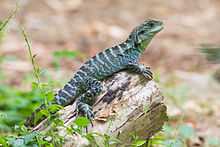Physignathus
- Physignathus is also a character in the Ancient Greek comedy Batrachomyomachia.
| Physignathus | |
|---|---|
 | |
| Physignathus lesueurii | |
| Scientific classification | |
| Kingdom: | Animalia |
| Phylum: | Chordata |
| Class: | Reptilia |
| Order: | Squamata |
| Family: | Agamidae |
| Subfamily: | Agaminae |
| Genus: | Physignathus Cuvier, 1829 |
| Species | |
|
Physignathus cocincinus | |
Physignathus is a genus of large, diurnal, arboreal, agamid lizards, commonly known as water dragons. The two species are the Chinese water dragon P. cocincinus, and the Australian water dragon P. lesueurii. They are sometimes kept as pets, especially P. cocincinus. Its generic name is Greek for "inflated jaw".
Species
- Physignathus cocincinus (Cuvier, 1829) is found throughout Southeast Asia, in Thailand, Cambodia, Vietnam, and south China. These lizards are semiaquatic, using their laterally compressed tails to propel themselves when swimming. They can remain submerged for long periods of time. Like many lizards, water dragons have parietal eyes, a light-sensitive "third eye" in the top of the head.
- Physignathus lesueurii (Gray, 1831) males are easily distinguished from the females as they have red-coloured chests and bellies, which are mostly visible when they lift their heads in defensive mode. This species occurs in the eastern states of Australia, and is locally designated as the eastern water dragon.[1] The species are usually shy creatures in the wild, that may only make themselves known to passers-by from the sound of them dropping into a waterway. However, in breeding season, the mothers may become more aggressive to distract any potential predators from capturing their young. Juveniles are very sociable, playful creatures and are usually found in groups ranging from three to eight young dragons.
References
- ↑ Maruyama, K., Langkilde, T. (1999). "Physignathus lesueurii" (PDF).
External links
| Wikispecies has information related to: Physignathus |
![]() Media related to Physignathus at Wikimedia Commons
Media related to Physignathus at Wikimedia Commons
- Physignathus at the Encyclopedia of Life